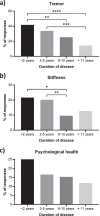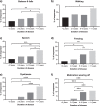People with Parkinson's Disease: What Symptoms Do They Most Want to Improve and How Does This Change with Disease Duration?
- PMID: 33459664
- PMCID: PMC8150663
- DOI: 10.3233/JPD-202346
People with Parkinson's Disease: What Symptoms Do They Most Want to Improve and How Does This Change with Disease Duration?
Abstract
Background: Parkinson's disease (PD) is a neurodegenerative condition with a diverse and complex pattern of motor and non-motor symptoms which change over time with disease duration.
Objective: The aims of the present study were to discover what symptoms matter most to people with the condition and to examine how these priorities change with disease duration.
Methods: A simple free-text online survey (using SmartSurvey) was developed by Parkinson's UK, which asked participants to identify up to three aspects of the condition they would most like to see improvement in.
Results: 790 people participated reporting 2,295 issues related to PD which were grouped into 24 broad symptom domains. Of these, 1,358 (59.1%) were categorised as motor symptoms, 859 (37.4%) as non-motor issues and 78 (3.4%) as medication problems. This study reveals how certain features of PD become more or less important to patients as the condition progresses. Non-motor symptoms were highly cited from the very earliest stages of PD. Problems with walking, balance and falls, speech problems, freezing and dyskinesia become increasingly important as the condition progresses whereas tremor, stiffness and psychological health become decreasingly important as the condition progresses.
Conclusions: The data suggest that the priorities of people affected by PD for improving life are personal and change with duration of the condition. These findings have implications for developing person-centred management and care, as well as for directing future research to improve quality of life.
Keywords: Parkinson’s disease; patient priorities; progression; quality of life; symptoms.
Conflict of interest statement
The authors have no conflict of interest to report.
Figures




References
-
- Parkinson’s UK (2017) The incidence and prevalence of Parkinson’s in the UK, Parkinson’s UK website, https://www.parkinsons.org.uk/news/parkinsons-diagnoses-set-increase-fif..., Posted January 8, 2018, Accessed July 30, 2020.
-
- Moustafa AA, Chakravarthy S, Phillips JR, Gupta A, Keri S, Polner B, Frank MJ, Jahanshahi M (2016) Motor symptoms in Parkinson’s disease: A unified framework. Neurosci Biobehav Rev 68, 727–740. - PubMed
-
- Chaudhuri KR, Healy DG, Schapira AHV (2006) Non-motor symptoms of Parkinson’s disease: Diagnosis and management. Lancet Neurol 5, 235–245. - PubMed
-
- Kalia LV, Lang AE (2015) Parkinson’s disease. Lancet 386, 896–912. - PubMed
-
- Hoehn MM, Yahr MD (1967) Parkinsonism: Onset, progression, and mortality. Neurology 17, 427–442. - PubMed
MeSH terms
LinkOut - more resources
Full Text Sources
Other Literature Sources
Medical

